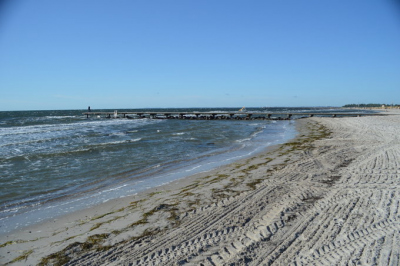Die Inhalte dieser Seite sind leider nicht auf Deutsch verfügbar.
Seitenpfad:
- INTERCOAST
- Latest News
- Archiv
- News 2015
- Field trip to Fehmarn
Field trip to Fehmarn
We also visited the NABU bird sanctuary on Fehmarn, hearing interesting guided tours of the preserve and the various avian species there.
We first departed from Bremen early on 14 September, driving several hours in vans to Puttgarden, the port on the northern side of Fehmarn. There, we parked the vans and boarded the Scandlines Ferry that connects Puttgarden to Rodby, Denmark. The ferry itself is impressive, complete with cafes, restaurants, and even rail tracks that carry the Hamburg-Copenhagen ICE train. Aboard the windy ferry, Intercoasters bonded over the beautiful views of the chilly Baltic.

INTERCOAST PhD students on the ferry - Picture by Peter de Ruiter
After the 45 minute journey to Rodby, we Intercoasters explored the small port town on foot and then joined engineering and public relations representatives from the Danish government at the Fehmarn Belt Tunnel museum at the port. There, we heard about the technically impressive efforts to construct the 18km car and rail tunnel that would connect Denmark and Germany. Their presentation discussed many of the concerns at the heart of the INTERCOAST program—biological, social, geotechnical, and legal issues surrounding coastal development and engineering. Regardless of the contested political issues of the project, we learned much about the immense scale and complex plans of the project.

Back on the ferry - Picture by Seth Gustafson
In the evening, we then crossed back across the Baltic on the ferry and drove to our overnight location on Fehmarn, Burg. In Burg, we enjoyed eating dinner together, walking around the town, and even stopping at Mopsy’s, a longtime local favorite hangout. Our hotel looked out over the Baltic, providing impressive views of the coastline and dark blue waters. Seeing together some of the local coastal culture of this corner of Germany was one highlight of the trip.
After breakfast on the 15th, we travelled to the headquarters of NABU on the western side of the island. There, we heard from representatives from a Fehmarn-based grass-roots organization opposed to the building of the Fehmarn Belt Tunnel. This group also discussed some of the same transdisciplinary concerns that drive INTERCOAST research: social and cultural impacts of coastal development; questions about development-related environmental consequences; and the highly detailed legal and public comment process involved in large infrastructure projects. Hearing both sides of the public debate was very stimulating and left us all with more questions and interest in this topic.
After a quick lunch break at NABU’s in-house restaurant, we then split into smaller groups for expert-led walking tours of the bird sanctuary. The preserve is quite extensive and has several blinds, towers, wetlands, and ponds at which to see some of the beautiful species on Fehmarn. This section of the Baltic is one of the most essential and well-travelled paths of bird migration in Europe. Thus, the sanctuary serves and important role in educating the public about the lives and migratory patterns of many bird species.

At the bird sanctuary - Picture by Peter de Ruiter

Bird Watching - Picture by Seth Gustafson
Our visit to Fehmarn was complete after the NABU visit. We then departed for Bremen, with plenty of new social, environmental, and legal topics to discuss both on the ride home and long after our field trip. Every INTERCOAST workshop culminates with some kind of field trip like this one. Like all of the others, our trip to Fehmarn represented a unique experience that not only brought this cohort of students closer together, but also educated us on the real-world developments in our fields of research.
Report by Dr. Seth Gustafson



